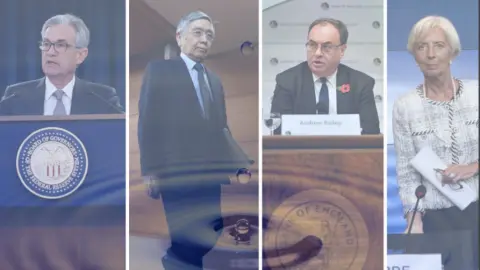Rates Outlook: The GBP curve is ahead of itself
For the GBP curve too, it will be difficult to escape the effects of monetary policy. The start of Bank of England tightening will provide some certainty, allowing long-end rates to recover and steepening the curve somewhat. Tightening should also mean a modicum of credit premia returning to money markets
GBP direction: Long-end taking the lead
|
Current value
|
Year ahead | 4Q21 | 1Q22 | 2Q22 | 3Q22 | 4Q22 |
|---|---|---|---|---|---|---|
|
10Y GBP swap
0.7%
|
Higher | 1% | 1.2% | 1.3% | 1.4% | 1.4% |
There has been a false start but, by all accounts, monetary policy tightening in the UK is going to start any time now. We think in February, and well before the US and eurozone. This will put GBP in a position of greater certainty in 2022 when it comes to the start date and extent of policy tightening.
The second factor that sets the GBP market apart is the fact that slightly too much tightening is priced in compared to our own estimate of the terminal rate in this cycle. According to our economics team, Bank Rate could reach 0.75%, conceivably 1% in the second half of 2023. This compares to markets routinely pricing 1.2% by mid-2023. We also find the terminal rate priced by the GBP curve inconsistent with other markets. For instance, the USD curve has routinely priced tightening worth roughly 150bp, while the EUR curve is pricing only in the region of 50bp. This may mean more upside to EUR and USD rates relative to GBP in 2022.
The front-end was the tail wagging the dog in 2021. 2022 should allow long-end specific factors to regain some influence
What does this imply for longer-dated GBP rates? The front-end was the tail wagging the dog in 2021. 2022 should allow long-end specific factors to regain some influence but we think this is only likely after the first BoE hike. Our view that the GBP curve is pricing too much tightening implies some mild downside risks to GBP rates. We think this is more likely to happen around BoE policy meetings.
The rest of the time, we expect GBP rates to drift higher alongside their international peers. This will take 10Y GBP swap rates (against Sonia) to 1.4% by the end of 2022. This level is consistent with the peak reached in late 2018 after the final BoE hike (to 0.75%). Upside risk is clear and dominates in our view. It stems mostly from inflation dynamics, as well as impulses from abroad, as the Federal Reserve and European Central Bank take decisive steps towards tightening policy.
The first BoE hike will allow long GBP rates to rise back
GBP curve: pancake no more
|
Current value
|
Year ahead | 4Q21 | 1Q22 | 2Q22 | 3Q22 | 4Q22 |
|---|---|---|---|---|---|---|
|
GBP 2s10s slope
0bp
|
Steeper | 0bp | 10bp | 15bp | 25bp | 25bp |
Starting with the overall trend, yield curves typically tend to flatten as the tightening cycle progresses. How early and how fast the flattening occurs depends on the level of the terminal rate and how it compares with the neutral rate for the economy. The latter is an ephemeral economic concept, but it has its use for rates markets. In this instance, we can infer that markets think the terminal rate (roughly 1.2%) is higher than the neutral rate, because the curve is implying that the BoE will subsequently cut rates.
More realistic BoE expectations mean that the curve will be allowed to re-steepen somewhat
This is a sign that markets view 115bp of tightening as more than the economy can bear. This is the main reason why the GBP curve flattened so aggressively in 2021 even before the BoE implemented its first hike. This is normally something that occurs much later in a hiking cycle, but BoE communication has led the market to price so aggressive a hiking cycle in 2022 that it would take the Bank Rate above neutral. The winter Covid-19 wave has contributed to the curve pricing a shallow tightening path. More realistic BoE expectations mean that the curve will be allowed to re-steepen somewhat.
In numbers, this means that the 2s10s segment will be allowed to re-steepen to 25bp by the end of 2022. This assumes that the BoE does not tighten policy beyond what the economy can support, and implies that there should still be a residual of term premium causing higher 10Y rates than 2Y rates, even if it is generally accepted that further hikes in the Bank Rate are unlikely beyond 1%.
A flat GBP term structure is no longer needed
BoE balance sheet reduction, the big shrug
Another interesting aspect of the UK being further along the road to policy tightening is that it should also be one of the first central banks to reduce its balance sheet. The BoE has signalled that it would start passive balance sheet reduction, ie, not reinvesting the proceeds of the gilts that mature in its portfolio, when Bank Rate reaches 0.5%. There is a high likelihood that it does at some point in 2022, after August in our forecast.
There is also the more questionable prospect of active balance sheet reduction, whereby the BoE would actively sell gilts it owns in its portfolio after Bank Rate reaches 1%. We do not assign a high probability to this scenario.
The impact of passive tightening is not easy to quantify, because it is simply the BoE failing to buy gilts in the market. In practice, markets have been very relaxed at the prospect. We think this reflects a number of factors. One is that the impact has been dampened by a reduction in gilts supply announced in October (see supply section). Another is that the policy has been flagged well in advance.
The more profound reason is that markets typically struggle to price events that will take place a long time in advance. If the BoE failing to reinvest the proceeds of its gilt portfolio creates a demand shortfall in future years but there is no demand shortfall at the present, the market will fail to reflect that until the balance between supply and demand actually shifts.
GBP money markets: Coming back to their senses
|
Current value
|
Year ahead | 4Q21 | 1Q22 | 2Q22 | 3Q22 | 4Q22 |
|---|---|---|---|---|---|---|
|
3M Sonia OIS
0.15%
|
Higher | 0.10% | 0.2% | 0.3% | 0.45% | 0.55% |
The GBP money market (MM) has lost its way during the Covid-19 pandemic. Not only did it fail to price any meaningful credit and liquidity risks, it also has in recent months been in the throes of massive BoE-induced volatility in OIS swaps.
We think a pre-condition for more normal functioning would be for OIS volatility to abate. As we wrote above, we think the start of the BoE cycle will go some way towards providing some stability to the front-end. We would also venture that the market’s difficulty in translating the MPC’s signal into a hiking path owes in part to the recent changes at the helm. We find it likely that the most challenging phase of the communication ‘training period’ is now behind us.
The BoE is ahead of its peers when it comes to unwinding the policy measures that have contributed to a cratering of MM spreads
This should set the stage for a recovery in the credit premia, as measured by the spread of commercial paper or Libor over matched-maturity OIS, in GBP money markets over the course of 2022. The BoE is somewhat ahead of its peers when it comes to unwinding the policy measures that have contributed to a cratering of these spreads. For instance, it stopped credit-specific measures long ago (eg, corporate bond and commercial paper purchase), and will be done with net QE purchases by end-2021.
The Bank Rate reaching 0.5% will also usher in an era of balance sheet reduction at the BoE. For the first time, the amount of liquidity, ultimately driving the price of credit in GBP money markets, will decline. This will, presumably, come at the same time as demand for reserves continues to grow. The last part is difficult to measure, and the two will probably catch up much later than 2022, but we expect the prospect to alter the pricing of credit with CP yields trading consistently above OIS.
The BoE will stop steamrolling money market spreads in 2022
Download
Download article
9 December 2021
Rates Outlook 2022: The liquidity overflow recedes This bundle contains 7 articles"THINK Outside" is a collection of specially commissioned content from third-party sources, such as economic think-tanks and academic institutions, that ING deems reliable and from non-research departments within ING. ING Bank N.V. ("ING") uses these sources to expand the range of opinions you can find on the THINK website. Some of these sources are not the property of or managed by ING, and therefore ING cannot always guarantee the correctness, completeness, actuality and quality of such sources, nor the availability at any given time of the data and information provided, and ING cannot accept any liability in this respect, insofar as this is permissible pursuant to the applicable laws and regulations.
This publication does not necessarily reflect the ING house view. This publication has been prepared solely for information purposes without regard to any particular user's investment objectives, financial situation, or means. The information in the publication is not an investment recommendation and it is not investment, legal or tax advice or an offer or solicitation to purchase or sell any financial instrument. Reasonable care has been taken to ensure that this publication is not untrue or misleading when published, but ING does not represent that it is accurate or complete. ING does not accept any liability for any direct, indirect or consequential loss arising from any use of this publication. Unless otherwise stated, any views, forecasts, or estimates are solely those of the author(s), as of the date of the publication and are subject to change without notice.
The distribution of this publication may be restricted by law or regulation in different jurisdictions and persons into whose possession this publication comes should inform themselves about, and observe, such restrictions.
Copyright and database rights protection exists in this report and it may not be reproduced, distributed or published by any person for any purpose without the prior express consent of ING. All rights are reserved.
ING Bank N.V. is authorised by the Dutch Central Bank and supervised by the European Central Bank (ECB), the Dutch Central Bank (DNB) and the Dutch Authority for the Financial Markets (AFM). ING Bank N.V. is incorporated in the Netherlands (Trade Register no. 33031431 Amsterdam).
